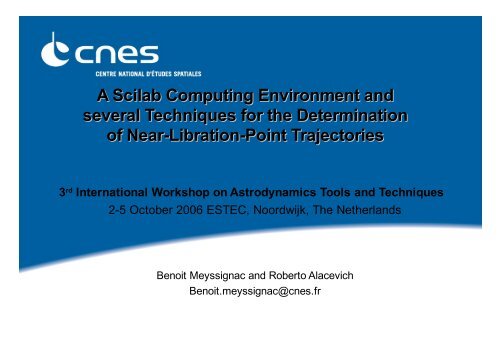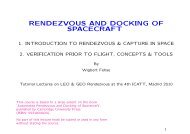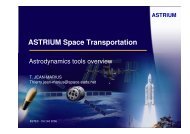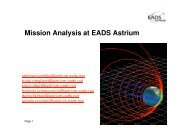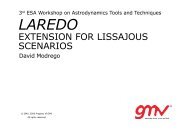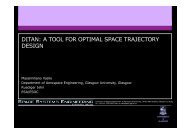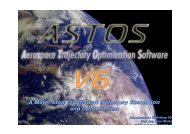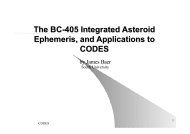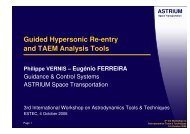A Scilab Computing Environment and several Techniques for the ...
A Scilab Computing Environment and several Techniques for the ...
A Scilab Computing Environment and several Techniques for the ...
Create successful ePaper yourself
Turn your PDF publications into a flip-book with our unique Google optimized e-Paper software.
A <strong>Scilab</strong> <strong>Computing</strong> <strong>Environment</strong> <strong>and</strong><strong>several</strong> <strong>Techniques</strong> <strong>for</strong> <strong>the</strong> Determinationof Near-Libration-Point Trajectories3 rd International Workshop on Astrodynamics Tools <strong>and</strong> <strong>Techniques</strong>2-5 October 2006 ESTEC, Noordwijk, The Ne<strong>the</strong>rl<strong>and</strong>sBenoit Meyssignac <strong>and</strong> Roberto AlacevichBenoit.meyssignac@cnes.fr
OUTLINECONTENTS! WHAT ?Tool that 4. Hypo<strong>the</strong>sis compute near-libration-points <strong>and</strong> Problem Statement trajectories under <strong>the</strong> threebody problem hypo<strong>the</strong>sis. (L1, L2 <strong>and</strong> L3)6. Numerical Calculation of Lissajous orbits! HOW ?8. Numerical Calculation of Halo orbitscoded in SCILAB.2. Tool architecture! WHY ?to design 2. Applications alternative trajectories <strong>and</strong> compute !V budget <strong>for</strong> phase0/A mission analysis studies.3 rd International Workshop on Astrodynamics Tools <strong>and</strong> <strong>Techniques</strong> 2
Numerical Calculation of Halo Orbits! Iterative ! Results method based on <strong>the</strong> symetry of <strong>the</strong> periodic orbits:if (x(t), y(t), z(t)) is a solution <strong>the</strong>n (x(-t), -y(-t), z(-t)) is also a solutionNumerical corrections:! Initial condition: X 0computed with <strong>the</strong> Richardson [1980] method to approximate at <strong>the</strong>Correction min Correction maxorder 3 <strong>the</strong> Halo orbitsAbsoluteNormalized1.10 -15! Numerical Absolute corrections: 3.10 -11 Newton method3.10 -122( XG:(x , y˙ , T)( X , T)Where " is <strong>the</strong> monodromy matrix of X 0at001.10 -143.10-10m/srelative8.10 -1246( X000, T), T)T3 rd International Workshop on Astrodynamics Tools <strong>and</strong> <strong>Techniques</strong> 5
Tool Architecture! set of C codes, <strong>Scilab</strong> scripts <strong>and</strong> <strong>Scilab</strong> functions h<strong>and</strong>led ei<strong>the</strong>r in new scripts or directlyfrom <strong>the</strong> <strong>Scilab</strong> prompt! Architecture: 3 directoriesutilities: contain all <strong>the</strong> basic ma<strong>the</strong>maticalprograms (integrators, computation of <strong>the</strong>monodromy…).algorithms: contain all <strong>the</strong> algorithmsmethods to generate special types of trajectories(halo types, related manifolds…).scripts: where <strong>the</strong>se algorithms can belinked (see figure).3 rd International Workshop on Astrodynamics Tools <strong>and</strong> <strong>Techniques</strong> 6
Applications! Phase 0 orbital Scenarii <strong>for</strong> <strong>the</strong> SAMPAN mission in <strong>the</strong> Sun Earth-Moon System! evaluation of <strong>the</strong> energy gap between <strong>the</strong> current keplerian orbit of 2000SG344 <strong>and</strong> aboundary 1 st option: lagrangian Large Lissajous orbit around L2 2 nd option: small Lissajous around L2Element value1- variationa (AU)eccentricityInclination(deg)Asc. node (deg)Arg. perih. (deg)M (deg)0.9773690.0669340.11192.335274.895288.3767.435e-073.956e-068.667e-060.0016360.0017260.0021343 rd International Workshop on Astrodynamics Tools <strong>and</strong> <strong>Techniques</strong> 7
! oncoming additionnal developments3 rd International Workshop on Astrodynamics Tools <strong>and</strong> <strong>Techniques</strong> 8


